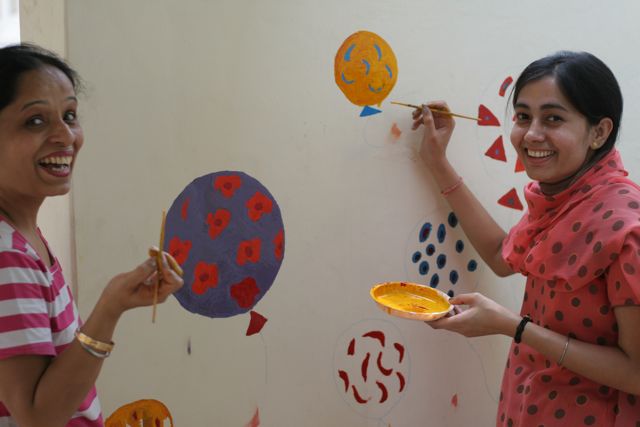
I love the Guru Ram Rai kids. Guru Ram Rai, the son of the seventh of the ten Sikh Gurus, is considered the founder of Dehradun (in India, where I live) and his followers are still based here. Among their many good works are a chain of schools which all look almost exactly alike and which specialize in very basic education for lower middle class children.
We have three of those schools in Vasant Vihar - one is around the corner from our Karuna Vihar school for kids with special needs and one is just two blocks down from our College for Vocational Training. You'd think they'd be used to us by now.
Not.
The picture above is how I usually see these kids: eager and curious and full of fun. They are AMAZED by me: How are you, Auntie? I am fine, Auntie. What is your name, Auntie? Where are you from, Auntie? And so on. When I take out the camera, chaos ensues as they push each other out of the way to pose, and then jostle into position to get a look at the results.
 Today was a little different. Today I had Moy Moy along. We had set out for a walk to the cycle-walla to get her stroller's tires filled with air just as the Guru Ram Rai schools got out for the day. This has to be seen to be believed, but trust me when I say that those children throng the already crowded streets with zero regard for safety or decorum or the slightest worry about making it home in one piece.
Today was a little different. Today I had Moy Moy along. We had set out for a walk to the cycle-walla to get her stroller's tires filled with air just as the Guru Ram Rai schools got out for the day. This has to be seen to be believed, but trust me when I say that those children throng the already crowded streets with zero regard for safety or decorum or the slightest worry about making it home in one piece.Moy and I were swept up in the flood and at first I welcomed it - the Guru Ram Rai kids! Hello, Auntie! What is your name, Auntie?
Except that today no one said a word. Not a single child smiled. Strangely silent, they walked by us in pairs or sets of three, staring in horror at Moy in her buggy. Some smirked, some poked the ones they were with to be sure they had seen: "So big! In a pram!" I heard one saying. As they walked past, almost every child turned back to keep looking.
It was very hard. I felt like crying. Moy Moy doesn't speak, so I don't know exactly how it felt to her, down there at waist level, watching all those children staring at her, perhaps wondering what they found so strange, perhaps wishing we hadn't come out at all.
We got the tires filled and we made our way back home. On the main road, we saw a family in the distance. Two men, one holding a baby, a woman, and two school-age children. The children were animated and excited. Long before we reached them, they were waving and calling out to us: "Hello, Didi! Hello Moy!" I heard the older one explaining to her parents: "It's Moy!"
They were Latika Vihar kids. They knew Moy Moy because she is one of them. She goes to Latika Vihar too. To them, she isn't that strange big child still riding around in a buggy. She isn't frightening or peculiar or someone to stay far away from. To them, she is a person with a story and a great stroller and a name. To them, she is Moy Moy.
I want to tell this story to people who don't believe in inclusion.
I can't get mad at those Guru Ram Rai kids when they stare at my daughter (even though I do). It's not their fault. They've never seen anyone like her. They've never seen anyone like her because we make sure that they don't. We keep kids like Moy Moy out of their schools and their playgrounds and their lives and then we expect them to be tolerant and accepting and inclusive.
How absurd.
It doesn't work like that. People accept what they understand. People accept what they have experienced. By keeping children with special needs away from their peers, we are guaranteeing their lifelong isolation.
I want to tell this story to people who don't believe in inclusion.






